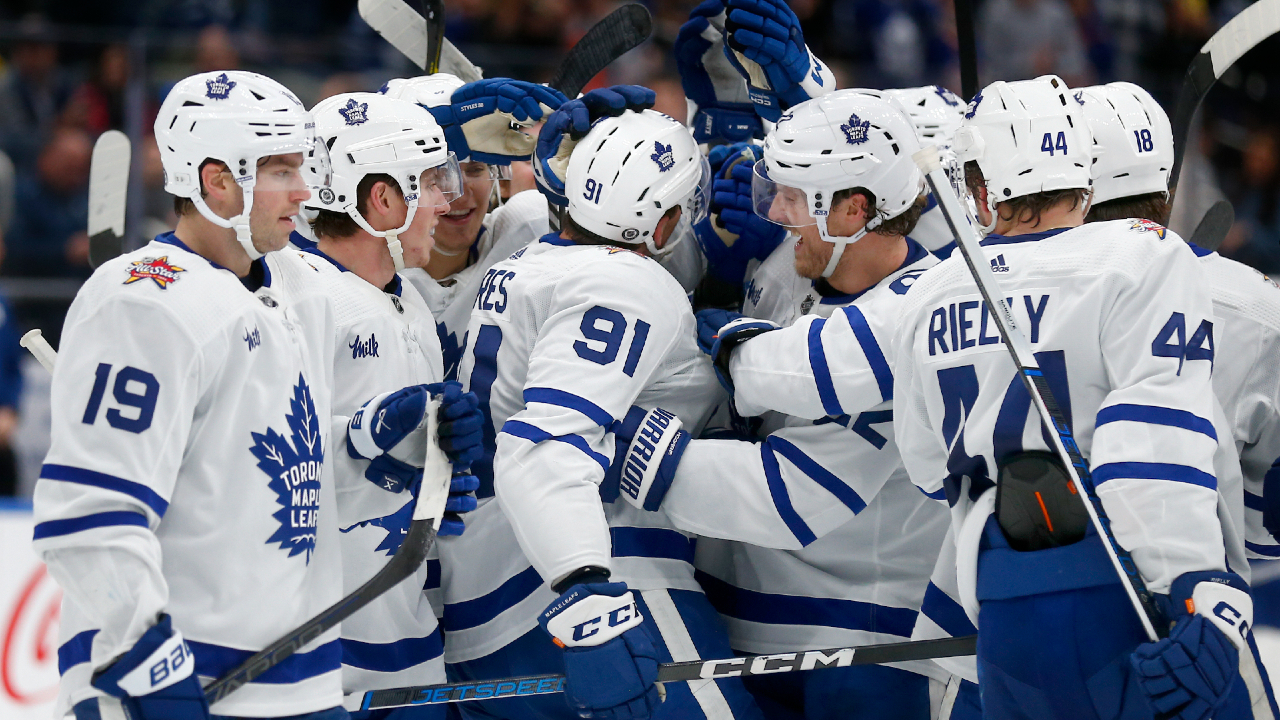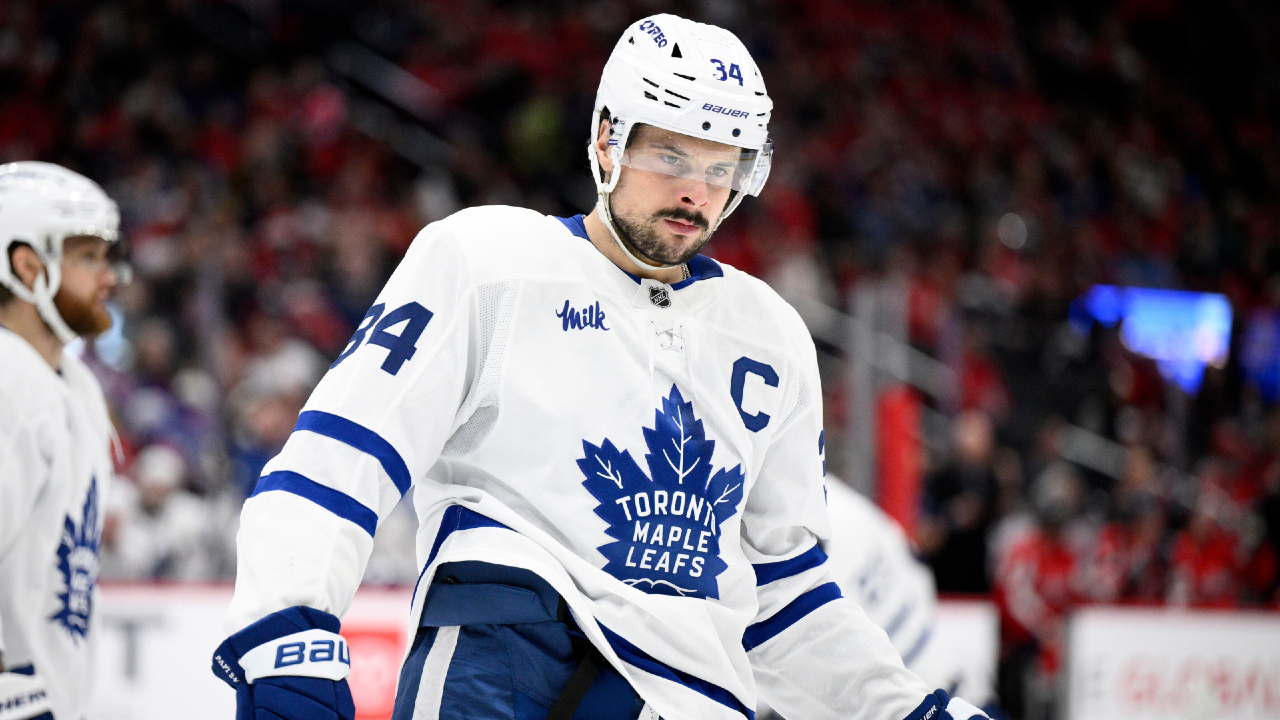
TORONTO — There are a lot of goals scored in Toronto Maple Leafs games.
They’re currently fifth in the NHL in goals per game, and better than that by expected goals. They’re also 22nd in goals against, and worse than that by expected goals. Scoring chances, goals, they come and go with 1980s-like frequency.
Going into games against the Leafs, the opponent’s message would be extremely predictable: we’re going to get our chances, so just stay patient, stay in the structure, and strike when the opportunities inevitably present themselves. With Joseph Woll hurt, and Ilya Samsonov sporting the 73st-best save percentage in the league (.878), that message would be doubly emphasized, as you’d expect to be able to convert on whatever chances come your way.
The Leafs were down 3-0 against Columbus halfway through their Thursday night contest when I made an aimless comment about what to expect the rest of the way: “Buckle in for 30 minutes of the Leafs taking offensive chances while Columbus goes into a shell.” I was covering the game with my co-host, Nick Kypreos, who responded to my comment with: “If they start taking chances now it’ll be 5-0.”
And sure enough, Kyp saw it coming. Heading into the third period, it was indeed 5-0 Columbus.
Which was, apparently for the Blue Jackets, enough to convince them it was time to go full Shell City.
We all know what happened from there. The Jackets played hockey’s version of football’s “prevent” defence, trying to keep the Leafs from getting breakaways or high-danger chances, which allowed them more time and space with the puck. And when you allow Toronto’s group of elite top-six forwards time and space with the puck and try to hang on for 20 minutes, you’re in real trouble.
Even if you’re up by five.
Few teams in the league can roll out four guys, or even three guys (Auston Matthews, Mitch Marner, William Nylander) so capable of picking holes in a passive defence. So they picked holes, took chances, and Columbus played hyper-low-risk which let Toronto keep taking the next swing, and eventually the Leafs’ high-skill players got it done. It was clear the Leafs had taken over, but it wasn’t clear if they’d have enough time to catch up.
They did.
That game should be a lesson for the league. Not that the Leafs can come back from anything, but that playing any kind of shell defence against skilled teams — even when leading — is a recipe for disaster in 2023-24.
Leads change hands more than they have in decades. Most teams take chances to play catch up when they fall behind, so the plan in today’s higher-scoring NHL should be to stay aggressive enough to get your own chances and score and run away with the game, rather than to hang on for dear life and eek out a close win.
As you’ll see in the goals-by-period chart below, the Leafs have only given up 23 third period goals, which is fourth-best in the NHL.
|
MAPLE LEAFS |
GF |
GA |
DIFFERENCE |
|
First period |
24 |
31 |
-7 |
|
Second period |
32 |
30 |
2 |
|
Third period |
36 |
23 |
13 |
|
OT |
3 |
5 |
-2 |
I don’t think the point here is “the Leafs are a late-game defensive stalwart,” it’s that they’ve been trailing a lot, so other teams stop pushing in anticipation of the Leafs getting more aggressive. (I actually think there’s a case that some of Toronto’s more positive offensive numbers are linked to chasing games as often as they have this season.)
The Leafs have been trailing after one period a dozen times this season, and they’ve only been beaten in regulation in those games…twice. They’ve been trailing after two periods a dozen times as well, and their opponents have still only put them away in regulation six times.
The Leafs are 6-2-4 when trailing after a period, which is both impressive and baffling.
There are certain things players do to “take chances” in hopes of breaking through. One is that wingers will often leave the defensive zone early, hoping that a bounce (or even just getting a step) allows them the chance to get in behind the opposing D.
In the offensive zone, defencemen will be more active pinching down the walls to keep possessions alive. They can get caught if the puck gets past them, but if it doesn’t, it’s of huge value to the offence.
A third forechecker can decide not to back out with the opposing breakout, but rather “dive in.” That basically means taking a big chance at attacking the puck and turning it right back over, which more than half the time will result in giving up a rush against (often odd-man) if it doesn’t work. But when you’re trailing, you’ve got to take some risks.
Handling the puck, players will try to beat the opposition 1-on-1 more, hoping to force a coverage breakdown. This is what happened when Columbus scored their fourth goal, as Matthews was basically on a 1-on-2, tried to beat a defenceman straight up, and that turnover lead to the Leafs’ blueliners having bad gap and TJ Brodie getting cooked wide by Yegor Chinakhov.
As much as coaches don’t like the idea of continuing to push for offence while holding a late lead, it’s a mindset thing. You’re not “pushing” or “forcing” anything. On that Columbus goal, when the Leafs hand you a turnover, you go with it. You can’t be content just dumping the puck in, getting back in your structure, and setting up to defend the Leafs’ latest battering ram attempt at your castle door.
Trying to score more when already up three and four goals is a concept largely foreign to NHL coaches. But with goal scoring up so high in the NHL the past few seasons, and goalie save percentages down just about every year over the past decade (from .915 to .904 on average), simply packing it in and defending just isn’t the smartest strategy, at least not in the regular season.
Leads change hands too much, players are too skilled, and you’ll find ways to blow games you started well, as Columbus has a whopping nine times this year. Keeping the pedal on the gas is the best way to beat not just the Leafs, but most of the top-third of NHL teams that have a handful of deadly scorers waiting to feast on the league’s most passive defences.








